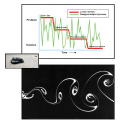Countering Violent Extremism: variants on a theme II
[ by Charles Cameron — modeling / scoring recruitment conversations as a flow of ideas, continued from CVE Variants I ]
.
Look, in any guidance, in any persuasion, there’s a conversation.
In the image above, the flow is from Anwar al-Awlaki, who already knows and speaks, to Nidal Hasan, who listens and thinks and is persuaded.
But what interests me more than that specific conversation, limited as it was to a handful of emails, is the overall route taken by many different conversations between what the NYPD calls a “spiritual sanctioner” and a prospective recruit.
We know that like a river, any conversation will have its eddies and flows — but if it’s a successful conversation, if it leads to persuasion, if it radicalizes the recruit… then the eddies won’t have prevented or reversed the flow, they’ll just have been a natural part of it.
*
Mitchell D. Silber and Arvin Bhatt addressed the stages they believed the radicalization process generally followed in their report for the NYPD, Radicalization in the West: The Homegrown Threat, and the steps they described after self-identification — in which the proto-jihadist comes to think of themselves as within the broad Salafist thought-stream, were these:
Indoctrination is the phase in which an individual progressively intensifies his beliefs, wholly adopts jihadi-Salafi ideology and concludes, without question, that the conditions and circumstances exist where action is required to support and further the cause. That action is militant jihad. This phase is typically facilitated and driven by a “spiritual sanctioner”.
While the initial self-identification process may be an individual act, as noted above, association with like-minded people is an important factor as the process deepens. By the indoctrination phase this self-selecting group becomes increasingly important as radical views are encouraged and reinforced.
Jihadization is the phase in which members of the cluster accept their individual duty to participate in jihad and self-designate themselves as holy warriors or mujahedeen. Ultimately, the group will begin operational planning for the jihad or a terrorist attack.
*
For the record: I do understand that the “conversational terrain” of the radicalization process is going to be considerably more twisty and convoluted than any map — as indeed do Silber and Bhatt, who write “Although this model is sequential, individuals do not always follow a perfectly linear progression.”
Let’s take a close look.
Here, for starters, is a diagram from Jeff Conklin, the guy who brought us wicked problems, showing in red the linear path that the creativity books tell you you should take from problem to solution — and in blue, the zigzag path an “actual” designer’s mind might take on its way to that solution — from the first chapter of Conklin’s book, Dialogue Mapping: Building Shared Understanding of Wicked Problems —
Page 1 of 3 | Next page

